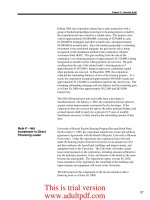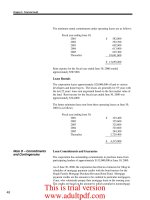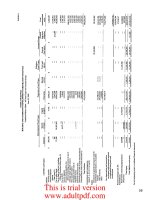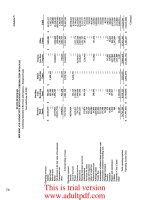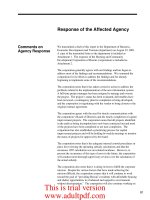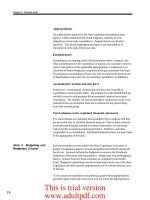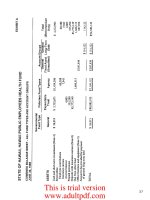bài giảng chapter 3 financial statements, cash flow, and taxes
Bạn đang xem bản rút gọn của tài liệu. Xem và tải ngay bản đầy đủ của tài liệu tại đây (87.27 KB, 38 trang )
3 - 1
Balance sheet
Income statement
Statement of cash flows
Accounting income versus cash flow
MVA and EVA
Personal taxes
Corporate taxes
CHAPTER 3
Financial Statements, Cash Flow, and
Taxes
3 - 2
Income Statement
2003
2004
Sales 3,432,000
5,834,400
COGS 2,864,000
4,980,000
Other expenses 340,000
720,000
Deprec. 18,900
116,960
Tot. op. costs 3,222,900
5,816,960
EBIT 209,100
17,440
Int. expense 62,500
176,000
EBT 146,600
(158,560)
Taxes (40%) 58,640
(63,424)
Net income 87,960
(95,136)
3 - 3
What happened to sales and net
income?
Sales increased by over $2.4 million.
Costs shot up by more than sales.
Net income was negative.
However, the firm received a tax
refund since it paid taxes of more
than $63,424 during the past two
years.
3 - 4
Balance Sheet: Assets
2003
2004
Cash 9,000
7,282
S-T invest. 48,600
20,000
AR 351,200
632,160
Inventories 715,200
1,287,360
Total CA 1,124,000
1,946,802
Gross FA 491,000
1,202,950
Less: Depr. 146,200
263,160
Net FA 344,800
939,790
Total assets 1,468,800
2,886,592
3 - 5
What effect did the expansion have on
the asset section of the balance sheet?
Net fixed assets almost tripled in
size.
AR and inventory almost doubled.
Cash and short-term investments
fell.
3 - 6
Statement of Retained Earnings: 2004
Balance of ret. earnings,
12/31/2003
203,768
Add: Net income, 2004
(95,136)
Less: Dividends paid, 2004
(11,000)
Balance of ret. earnings,
12/31/2004
97,632
3 - 7
Balance Sheet: Liabilities & Equity
2003
2004
Accts. payable 145,600
324,000
Notes payable 200,000
720,000
Accruals 136,000
284,960
Total CL 481,600
1,328,960
Long-term debt 323,432
1,000,000
Common stock 460,000
460,000
Ret. earnings 203,768
97,632
Total equity 663,768
557,632
Total L&E 1,468,800
2,886,592
3 - 8
What effect did the expansion have on
liabilities & equity?
CL increased as creditors and
suppliers “financed” part of the
expansion.
Long-term debt increased to help
finance the expansion.
The company didn’t issue any stock.
Retained earnings fell, due to the
year’s negative net income and
dividend payment.
3 - 9
Statement of Cash Flows: 2004
Operating Activities
Net Income
(95,136)
Adjustments:
Depreciation
116,960
Change in AR
(280,960)
Change in inventories
(572,160)
Change in AP
178,400
Change in accruals
148,960
Net cash provided by ops.
(503,936)
3 - 10
Long-Term Investing Activities
Cash used to acquire FA
(711,950)
Financing Activities
Change in S-T invest.
28,600
Change in notes payable
520,000
Change in long-term debt
676,568
Payment of cash dividends
(11,000)
Net cash provided by fin. act.
1,214,168
3 - 11
Summary of Statement of CF
Net cash provided by ops.
(503,936)
Net cash to acquire FA
(711,950)
Net cash provided by fin. act.
1,214,168
Net change in cash
(1,718)
Cash at beginning of year
9,000
Cash at end of year
7,282
3 - 12
What can you conclude from the
statement of cash flows?
Net CF from operations = -$503,936,
because of negative net income and
increases in working capital.
The firm spent $711,950 on FA.
The firm borrowed heavily and sold
some short-term investments to
meet its cash requirements.
Even after borrowing, the cash
account fell by $1,718.
3 - 13
What is free cash flow (FCF)?
Why is it important?
FCF is the amount of cash available
from operations for distribution to all
investors (including stockholders
and debtholders) after making the
necessary investments to support
operations.
A company’s value depends upon
the amount of FCF it can generate.
3 - 14
What are the five uses of FCF?
1. Pay interest on debt.
2. Pay back principal on debt.
3. Pay dividends.
4. Buy back stock.
5. Buy nonoperating assets (e.g.,
marketable securities, investments in
other companies, etc.)
3 - 15
What are operating current assets?
Operating current assets are the CA
needed to support operations.
Op CA include: cash, inventory,
receivables.
Op CA exclude: short-term
investments, because these are
not a part of operations.
3 - 16
What are operating current liabilities?
Operating current liabilities are the
CL resulting as a normal part of
operations.
Op CL include: accounts payable
and accruals.
Op CA exclude: notes payable,
because this is a source of
financing, not a part of operations.
3 - 17
What effect did the expansion have on
net operating working capital (NOWC)?
NOWC
04
= ($7,282 + $632,160 + $1,287,360)
- ($324,000 + $284,960)
= $1,317,842.
NOWC
03
= $793,800.
= -
Operating
CA
Operating
CL
NOWC
3 - 18
What effect did the expansion have on total
net operating capital (also just called
operating capital)?
= NOWC + Net fixed assets.
= $1,317,842 +
$939,790
= $2,257,632.
= $1,138,600.
Operatin
g
capital
04
Operatin
g
capital
03
Operating
capital
3 - 19
Did the expansion create additional net
operating profit after taxes (NOPAT)?
NOPAT = EBIT(1 - Tax rate)
NOPAT
04
= $17,440(1 - 0.4)
= $10,464.
NOPAT
03
= $125,460.
3 - 20
What was the free cash flow (FCF)
for 2004?
FCF = NOPAT - Net investment in
operating capital
= $10,464 - ($2,257,632 - $1,138,600)
= $10,464 - $1,119,032
= -$1,108,568.
How do you suppose investors reacted?
3 - 21
Return on Invested Capital (ROIC)
ROIC = NOPAT / operating capital
ROIC
04
= $10,464 / $2,257,632 = 0.5%.
ROIC
03
= 11.0%.
3 - 22
The firm’s cost of capital is 10%. Did
the growth add value?
No. The ROIC of 0.5% is less than the
WACC of 10%. Investors did not get
the return they require.
Note: High growth usually causes
negative FCF (due to investment in
capital), but that’s ok if ROIC > WACC.
For example, Home Depot has high
growth, negative FCF, but a high
ROIC.
3 - 23
Calculate EVA. Assume the cost of
capital (WACC) was 10% for both years.
EVA = NOPAT- (WACC)(Capital)
EVA
04
= $10,464 - (0.1)($2,257,632)
= $10,464 - $225,763
= -$215,299.
EVA
03
= $125,460 - (0.10)($1,138,600)
= $125,460 - $113,860
= $11,600.
3 - 24
Stock Price and Other Data
2003
2004
Stock price $8.50
$2.25
# of shares 100,000
100,000
EPS $0.88
-$0.95
DPS $0.22
$0.11
3 - 25
What is MVA (Market Value Added)?
MVA = Market Value of the Firm -
Book Value of the Firm
Market Value = (# shares of stock)
(price per share) + Value of debt
Book Value = Total common equity +
Value of debt
(More…)



